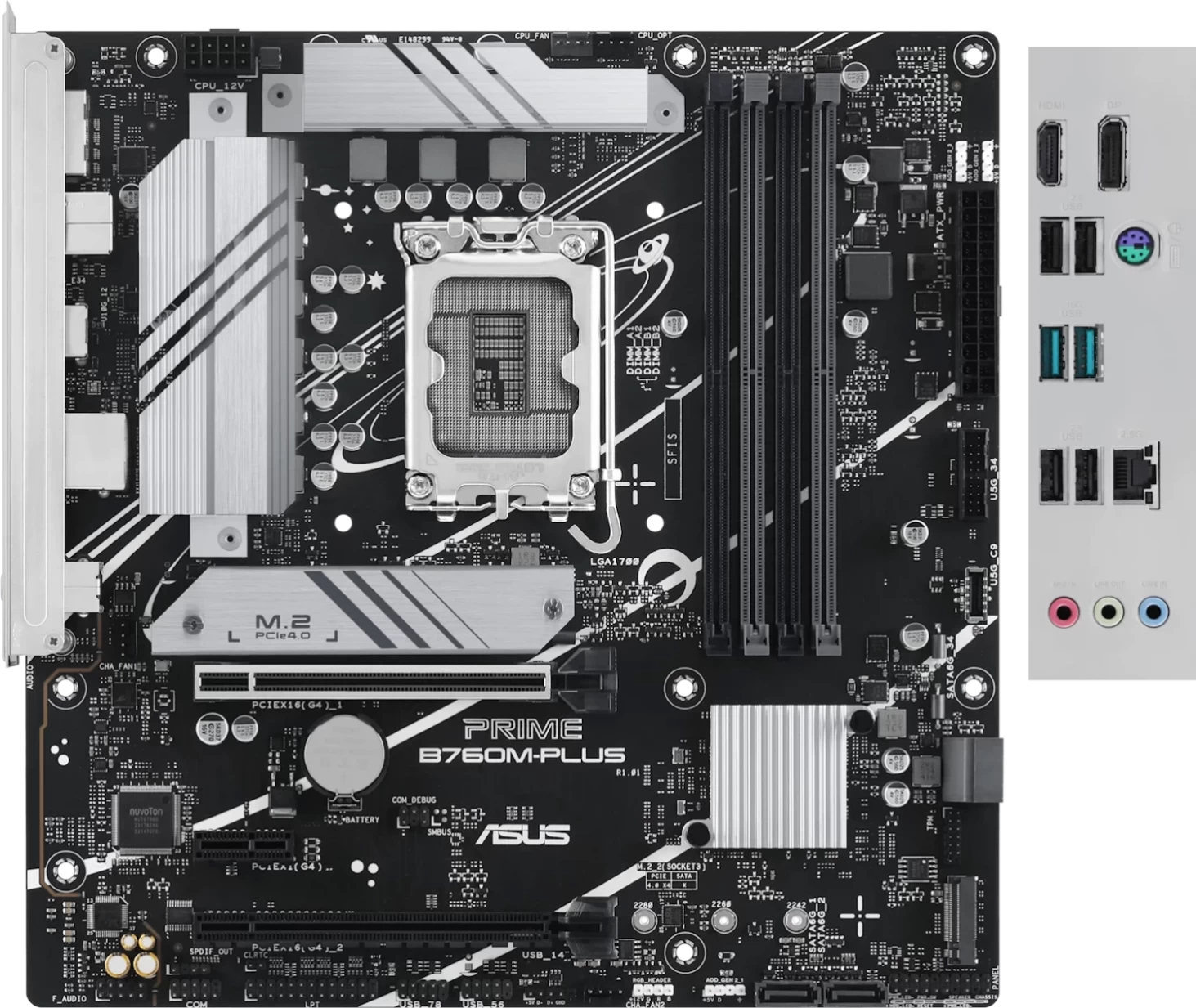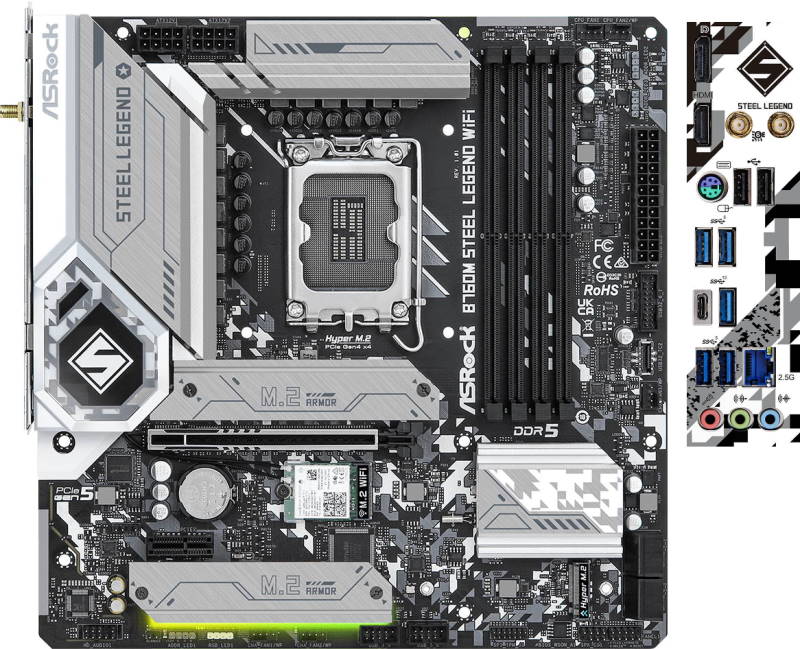Best Motherboards with Intel B760 Chipset
We independently test the products and technologies that we recommend.


| MTA.ua | 6 499 ₴ | To Store |
| Click.ua | 6 059 ₴ | To Store |
| Nkt.ua | 6 200 ₴ | To Store |
| Openshop.ua | 6 400 ₴ | To Store |
| Luckylink.kiev.ua | 6 127 ₴ | To Store |
The MSI PRO B760-P WIFI DDR4 represents an example of a quality, well-balanced, modern, and not-too-expensive motherboard for Intel 12th, 13th, and 14th generation processors. The model belongs to the ATX format, which imposes no restrictions during assembly and is based on the mid-level B760 system logic. Like its PRO series brethren, it is made in accordance with the concept of increased reliability, including the use of dense textolite, reinforced mounts, and high-quality components.
The MSI PRO B760-P WIFI DDR4 is equipped with four DIMM DDR4 sockets, allowing the installation of up to 128 GB of RAM with a fairly high maximum frequency of 5333 MHz for this standard. However, the sense in this is not so significant since as frequency increases from 3200 MHz, the cost of such memory grows disproportionately, making a pair of DDR4-4000 sticks one and a half times more expensive than an identical DDR5 set with a frequency of 4800 MHz. For storage organization, there are 2 high-speed M.2 PCI-E 4.0 slots and 4 regular SATA 3 connectors. Additionally, the board can work without a separate video adapter, in which case the monitor can be connected using HDMI or DisplayPort to the video card integrated into the processor.
These characteristics notably exceed the requirements of regular office and home PCs, so this model would rather be a successful option for a mid-level gaming PC or a workstation for coding, music creation, video processing, etc. Fortunately, all key zones are equipped with additional cooling, and the 14-phase power converter will easily accommodate even a powerful and power-hungry 20-core processor such as the Core i7-14700K. Some might be concerned by the lack of PCI-E 5.0, but how relevant is this for the middle market?

The Gigabyte B760 DS3H DDR5 is a full-format motherboard, which, although it belongs to the entry-level by fact, is built on a mid-class Intel B760 chipset with all the consequent effects. Due to the successful combination of functionality and reasonable cost, it is suitable for mid-level gaming and work builds that are not targeted for extreme overclocking.
The model's merits list includes a rather productive 11-stage power converter (schema 8+2+1), whose capabilities are perfect for powering Intel Core i5 and i7 processors. During the board production, dense composite printed circuit board material was used, the VRM zone is cooled by a dense and compact aluminum radiator, the M.2 ports are covered with special thermal pads, and the memory module mounts are equipped with durable EZ Latch locks. The case cooling is managed by the same Smart Fan 6 system used in the company's more upscale boards from the Aorus series.
The rest of the technical set is not left behind. The board's assets include 4 DDR5 slots with a maximum operating frequency of 7600 MHz, a couple of M.2 slots supporting PCIe 4.0 jet SSDs, a gigabit network controller, PerfDrive technology support, a modern set of video outputs, and more than ten USB ports of various classes (note: includes USB C 3.2 gen2x2). The lack of PCI-E 5.0 could be noted as a drawback, as seen with many competitors on the B760 chipset, but nearly any test nowadays says that modern games do not benefit from this feature. The question is, what will happen in a couple of years?

| Telemart.ua | 6 299 ₴ | To Store |
| Artline.ua | 6 299 ₴ | To Store |
| MTA.ua | 6 399 ₴ | To Store |
| Flick І Все для геймерів | 6 319 ₴ | To Store |
| Nkt.ua | 5 458 ₴ | To Store |
The Asus PRIME B760M-PLUS (90MB1GY0-M0EAY0) motherboard is part of a series of affordable components with maximum capabilities for building a powerful workstation or entry-level gaming machine based on the B760 chipset (socket LGA 1700). The multi-layered construction with solid capacitors, quality MOP-transistors, and a 7+1+1 power system provide stable operation for the 14th generation processor, which requires only one 8-pin line, and advanced 40XX series video cards. The model is focused on high-speed DDR5 7200 MHz RAM, allowing you to extract maximum performance from the system. Among the limitations, the lack of PCI-E 5.0 support, which is declared for the chipset, can be highlighted. The manufacturer emphasized reliability, adding VRM zone and M.2 storage heatsinks to prevent throttling under high loads. The main PCI-E slot is reinforced with a metal insert and withstands massive video adapters.
The board's firmware allows for flexible parameter adjustments and customization for specific tasks. An expert mode in UEFI is available for experienced users, while beginners can use intelligent automation. Additional software for monitoring the status of connected devices and quickly adapting the cooling system for loads or quiet operation is also available. The motherboard offers effective noise reduction during online learning, team communication during battle. The microATX form factor is aimed at compact assembly, and the availability of connectors for RGB and ARGB allows you to significantly diversify the aesthetics and synchronize all visual effects according to the Asus Aura Sync concept. Additional benefits include USB-C with output to the front panel.

The Asus TUF GAMING B760M-PLUS is a compact micro-ATX motherboard with an Intel 1700 processor socket, mid-level Intel B760 chipset, Thunderbolt interface support, and typical for micro-ATX set of connectors for storage drives (2 M.2 PCI-E 4.0 + 4 SATA3) and RAM (4 DIMM DDR5-7200).
Like all members of the TUF series, the model emphasizes the enhanced quality and longevity of the board through the use of dense multi-layer textolite, optimized power system, DrMOS power modules, and reinforced connectors for memory modules and video cards. With advanced technical characteristics and an efficient 13-phase power subsystem, the board implies the possibility of installing a high-performance Core i7 processor, a powerful video card like the GeForce RTX 4070, and several reactive M.2 PCI-E 4.0 SSD-drives.
It seems like with the TUF series, the Taiwanese have found the optimal formula that they do not plan to change, thus the evaluation for Asus TUF GAMING B760M-PLUS turns out quite predictable: it is a well-balanced and well-built mid-market board, costing only slightly more than Prime models and it can boast useful features like Fan Xpert cooling control software, Optimem memory accelerator, and “dual” UEFI BIOS with standard and advanced setting modes.

| Timesport.com.ua | 7 375 ₴ | To Store |
| Foco.com.ua | 7 700 ₴ | To Store |
| Denika.ua | 7 372 ₴ | To Store |
| Rozetka.ua | 10 217 ₴ | To Store |
| Tomdom.in.ua | 7 372 ₴ | To Store |
The ASRock B760M Steel Legend WiFi motherboard offers a host of advanced solutions aimed at professional gaming without special surcharges. The company managed to achieve high reliability and efficiency indicators in stressful situations and under increased loads. Among the main advantages of the model is a 14-phase power scheme with the Dr.MOS power module. The latter stabilizes the voltage, ensures the stable performance of components, and protects them from force majeure. The board's design provides a comprehensive heatsink encasement for rapid heat dissipation and prevention of primary component failure. Notable is the protection scheme for RAM modules in operation or replacement. Connection sockets are reinforced with metal inserts, endure many assembly cycles in case of component testing and similar use.
The manufacturer realized all the benefits of the updated B760 chipset, so the board covers most gamers and enthusiasts' needs regarding performance and overclocking. The key advantages include support for progressive DDR5 RAM at 7200 MHz and the PCI-E 5.0 standard, built on SMT technology for stable functioning of powerful video cards and unlocking their full potential. The rear panel includes a standard USB-C 3.2 gen2 port for connecting modern drives, lightning-fast data exchange, effective gadget charging. An interesting solution is the eDP connector intended for a proprietary 13.3-inch screen. It mounts on the case and provides visual PC status monitoring. The motherboard offers comprehensive support and customization in design (built-in and additional LED lighting with ASRock Polychrome Sync synchronization), network connection (standard Wi-Fi 6E and LAN 2.5 Gbit module), traffic control, audio accompaniment (Nahimic sound enhancement and noise reduction algorithms).
Articles, reviews, useful tips
All materials





































